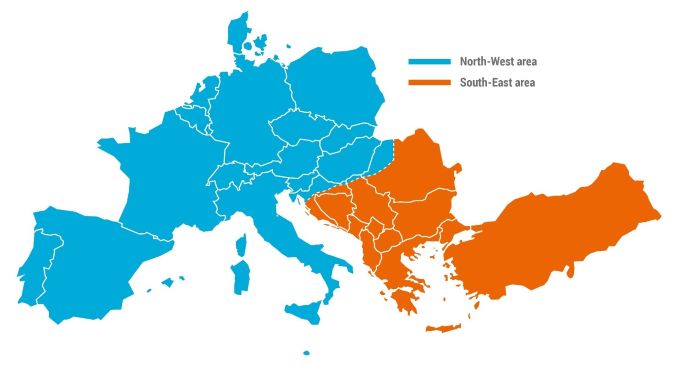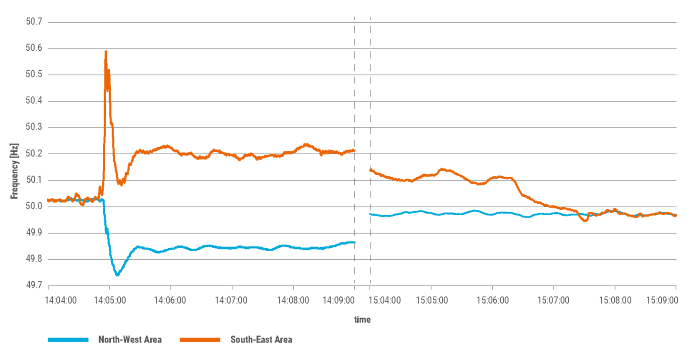On 8 January 2021 at 14:05 CET the synchronous area of Continental Europe was separated into two separated areas due to outages of several transmission network elements in a very short time. The route where the two areas were separated is the following:

Figure 1 - Map of Continental Europe showing the two separated areas during the system event on 8 January 2021
At approximately 14:05 CET, the frequency in the North-West Area of Continental Europe initially decreased to a value of 49.74 Hz within a period of around 15 seconds. Afterwards, the frequency reached a steady state value of approximately 49.84 Hz. At the same time, the frequency in the South-East Area initially increased to a value of up to 50.6 Hz before settling at a steady state frequency between 50.2 Hz and 50.3 Hz. This can also be seen from the graph below.

Figure 2 - Frequency in Continental Europe during the event on 8 January 2021
Due to the underfrequency in the North-West Area, the contracted interruptible services in France and Italy, in total around 1.7 GW, were disconnected in order to reduce the frequency deviation. These services are large customers, who are contracted by the respective Transmission System Operators (TSOs) and get disconnected if frequency drops under a certain threshold. In addition, 420 MW and 60 MW of supportive power were automatically activated from the Nordic and Great Britain Synchronous areas respectively. These countermeasures ensured that, already at 14:09 CET, the frequency deviation was limited to a deviation of around 0.1 Hz in the North-West Area from the nominal frequency of 50 Hz (see Figure 2).
Due to the large overfrequency in the South-East Area, automatic and manual countermeasures were activated (i.e. the reduction of the feed-in of generation units) in order to stabilise the frequency. Thus, at 15.05 CET the frequency deviation in the South-East Area could be limited to +0.1 Hz from the nominal frequency of 50 Hz (see Figure 2).
The automatic response and the coordinated actions taken by the TSOs in Continental Europe ensured that the situation was quickly restored to normal operations. Actions were coordinated between the TSOs in order to reconnect the two areas as fast as possible again. Therefore, the contracted interruptible services in Italy could be reconnected at 14:47 CET and in France at 14:48 CET. At 15:08 CET, both areas were connected again to one synchronous area in Continental Europe.
ENTSO-E has kept the European Commission and the Electricity Coordination Group composed of representatives of Member States informed.
ENTSO-E is also publishing today questions and answers with regards to this event. All information published is subject to the results of a detailed investigation on the event which is ongoing. The investigation is following the legal framework under the Commission Regulation (EU) 2017/1485 of 2 August 2017 (System Operation Guideline) whereby National Regulatory Authorities and ACER are invited to join together with TSOs in the Investigation Panel.
In line with the provisions of the Commission Regulation (EU) 2017/1485 of 2 August 2017 (System Operation Guideline), ENTSO-E will present the results of the investigation to the Electricity Coordination Group and will subsequently publish them once the analysis is completed.
Questions and answers
What is a system separation?
The transmission grids of the countries of Continental Europe are electrically tied together to operate synchronously at the frequency of approximately 50 Hz. An event on 8 January 2021 caused the Continental Europe synchronous area to separate into two areas, with an area in the South-East of Europe being temporarily operating in separation from the rest of Continental Europe.
Is this the first time such an event happens in Continental Europe?
The Continental Europe synchronous area is one of the largest interconnected synchronous electricity systems in the world in terms of its size and number of supplied customers. Such a kind of events can happen in any electric power system. System resilience and preparedness of system operators in charge have a decisive impact on the consequences of such events. A separation of the synchronous area with a much larger disturbance and impacts on customers took place in Continental Europe on the 4 November 2006. This event was extensively analysed and led to a number of substantial developments, like the European Awareness System (EAS) which is a platform allowing TSOs to exchange operational information in real time, enabling them to react immediately in case of unusual system condition. The TSOs are therefore well prepared in order to coordinate and manage such events and limit the consequences. This preparedness and a permanent observation of the system frequency allowed to resynchronize the two separated areas in a very short period of time.
How are countermeasures coordinated in Continental Europe in case of frequency deviations?
In Continental Europe, procedures are in place to avoid system disturbances and especially large frequency deviations with the risk of uncoordinated disconnection of customers or generation. The TSOs Amprion (Germany) and Swissgrid (Switzerland) are responsible for these procedures in their role as synchronous area monitor (SAM) in Continental Europe. The SAM continuously monitors the system frequency. In case of large frequency deviations, they inform all TSOs via the European Awareness System (EAS) and launch an extraordinary procedure for frequency deviations to coordinate countermeasures in a fast and effective manner in order to stabilize the system. One step of this procedure is a telephone conference by Amprion, Swissgrid, RTE (France), Terna (Italy) and REE (Spain). This teleconference took place at 14:09 CET on 8 January 2021. In the telephone conference, the situation was evaluated, the TSOs informed about countermeasures which were already activated. The TSOs of the North-West and South-East area also coordinated the actions for reconnection in order to reach one synchronous area in Continental Europe again.
Were end customers disconnected? Were there any other consequences?
Customers in the order of 70 MW in the North-West Area and in the order of 163 MW in the South-East Area were disconnected. Due to the high resilience of the interconnected network and the rapid response of European TSOs, the security of operation and electricity supply was not endangered. An important contribution to stabilizing the system was delivered by the previously contracted interruptible services, which were activated in France and Italy. Such contracts which have been agreed with customers allow the TSO to temporarily and automatically reduce their electrical consumption depending on the situation with the electric power system in real-time.
What caused the separation?
In line with the provisions of the System Operation Guideline, a detailed investigation is ongoing on the event. This includes a comprehensive analysis of large numbers of real-time recordings from protection devices and other electric power system elements. ENTSO-E will publish the results of this investigation as soon as the analysis is finalised.
Press Contact: Claire Camus +32 476 975093 claire.camus@entsoe.eu
 ENTSO-E
ENTSO-E